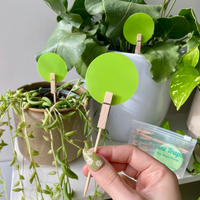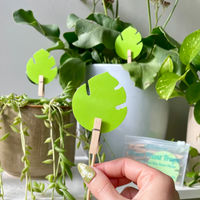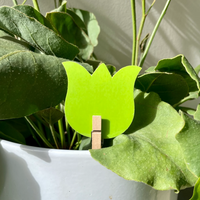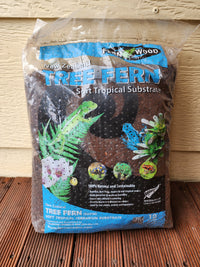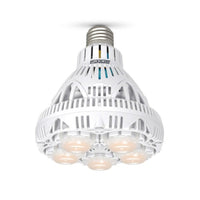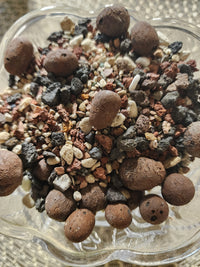Australia’s indoor gardeners often face limited natural sunlight—nearly half of urban homes struggle to provide enough luminous intensity for healthy foliage. Attaching a purpose-built grow light ensures consistent photosynthetic support, promoting robust growth, vibrant leaves and year-round greenery. This guide explores what makes grow lights essential, compares LED, fluorescent and HID options, outlines selection criteria like wattage and fixtures, details optimal setup and usage, and highlights Leaf of Faith’s top-rated products. Discover how to boost plant vitality with the best grow light for houseplants and transform any space into a thriving indoor oasis.
What Makes a Grow Light Essential for Healthy Houseplants in Australia?
A grow light is an artificial light source that emits the photosynthetically active radiation (PAR) wavelengths needed for year-round foliage development and stronger root systems. Seasonal daylight variation and limited window exposure in Aussie homes often lead to light deficiency, making supplemental illumination critical for lush growth. This section covers how inadequate light impacts plants, how to spot warning signs and the science behind light-driven photosynthesis.
How Does Light Deficiency Affect Australian Indoor Plants?
Light deficiency occurs when plants receive insufficient luminous energy, triggering leggy stems and pale leaves due to reduced chlorophyll synthesis. Common symptoms include:
- Stretched internodes weaken the stem structure.
- Dull or yellowing foliage from low chlorophyll content.
- Delayed budding and sparse leaf production.
Early intervention with a grow light prevents structural weakness and leaf drop, preparing plants for diagnostic assessment of their light needs.
What Are the Signs Your Houseplants Need a Grow Light?
Houseplants lacking adequate illumination display stretched internodes, yellowing foliage and slow new growth, indicating light stress. Look for:
- Overextended stems reaching toward windows.
- Leaf margins are turning translucent or yellow.
- Sparse new leaves are appearing underdeveloped.
Recognising these signs signals the need for targeted spectral support to restore vigorous development.
How Do Grow Lights Support Photosynthesis and Plant Growth?
Grow lights provide targeted spectrums that drive chlorophyll absorption, enabling photosynthesis and boosting biomass accumulation. Grow Light delivers full-spectrum light that enhances Photosynthesis, while balanced red and blue wavelengths regulate flowering and leaf expansion. Integrating this artificial spectrum reduces seasonal growth gaps and strengthens overall plant resilience.
The Science of Photosynthesis
Photosynthesis is the process by which plants convert light energy into chemical energy in the form of glucose, which fuels their growth and development. This process is crucial for plant survival and is directly influenced by the quality and quantity of light available.
Which Types of Grow Lights Are Best for Australian Houseplants?

Grow light types vary by technology—LED, fluorescent and HID systems each offer distinct wavelength outputs, energy efficiency profiles and lifespan benefits. Understanding their core attributes helps you choose the ideal solution for your collection.
| Grow Light Type | Attribute | Value |
|---|---|---|
| LED | Energy efficiency | High |
| Fluorescent | Heat output | Low |
| HID | Light intensity | Very high |
Selecting the appropriate type balances energy costs, coverage area and plant requirements.
Why Are LED Grow Lights the Top Choice for Australian Homes?
LED grow lights deliver adjustable spectra with high energy efficiency, reducing electricity usage while promoting vigorous foliage. Their low-heat output preserves delicate leaves and walls, and a long lifespan minimises replacements.
LED Grow Light Advantages
LED grow lights are energy-efficient and offer adjustable spectra, making them a popular choice for indoor gardening. They produce less heat than traditional grow lights, reducing the risk of damaging plants and the surrounding environment. The long lifespan of LEDs also minimises the need for frequent replacements.
When Should You Consider Fluorescent or HID Grow Lights?
Fluorescent and HID grow lights suit specific growing scenarios: fluorescent for seedlings or low-light plants and HID for large-scale fruiting or flowering setups that demand intense light.
- Fluorescent lights offer a gentle blue spectrum ideal for young sprouts.
- HID systems produce robust red and far-red light for prolific blooms.
These alternatives provide niche benefits when a one-size-fits-all LED system falls short.
What Is Full-Spectrum Light and Why Does It Matter for Houseplants?
Full-spectrum light mimics natural sunlight across red, blue and green wavelengths, ensuring balanced plant development from leaf expansion to flowering. Plants absorb each spectrum band for distinct growth phases: blue for foliage, red for blooms and green for fine-tuning pigment production.
Explore our range to match natural sunlight indoors.
How Do You Choose the Best Grow Light for Your Houseplants?
Choosing the best grow light involves matching wattage, spectrum and fixture design to each plant’s light requirement, ensuring optimal photosynthetic efficiency. Focus on exactly aligned light intensity, energy usage and equipment flexibility to support diverse indoor gardens.
What Wattage and Light Intensity Do Different Houseplants Need?
Houseplants demand a suitable amount of wattage per square foot, depending on leaf density and growth stage, with higher intensities for flowering varieties like orchids.
| Houseplant Category | Recommended Wattage | Light Intensity |
|---|---|---|
| Low-light | Moderate | Sufficient |
| Medium-light | Higher | Good |
| High-light | Substantial | High |
Light Intensity and Plant Needs
Different plants have varying light requirements, with flowering varieties often needing higher light intensities than low-light species. The amount of light a plant needs is typically measured in watts per square foot, and this varies depending on the plant's growth stage and type.
How Do Timers and Dimmers Improve Grow Light Efficiency?
Timers and dimmers automate light schedules and intensity control, aligning illumination periods with plant circadian rhythms and saving energy. They enable:
- Consistent photoperiod management without manual intervention.
- Power consumption reduction by adjusting output during off-peak hours.
- Extended lamp lifespan through gradual power modulation.
Which Fixture Types Are Suitable for Various Indoor Spaces?
Grow light fixtures come in clip-on, hanging and freestanding designs, each suited to different spatial constraints and aesthetic preferences.
| Fixture Type | Attribute | Ideal Use |
|---|---|---|
| Clip-on | Adjustability | Small pots and shelves |
| Hanging | Coverage area | Vertical gardens and tall plants |
| Stand | Stability | Multi-shelf setups |
Selecting the right fixture ensures even light distribution and fits your room layout perfectly.
How Should You Set Up and Use Grow Lights for Optimal Plant Health?

A proper grow light setup aligns distance, duration and maintenance to plant needs, maximising photosynthetic output and preventing light stress. The following sections guide placement, scheduling and system care.
What Is the Ideal Distance Between Grow Lights and Houseplants?
The ideal distance ranges from 15 to 45 cm, depending on light intensity, with LEDs positioned further back to avoid hotspots and fluorescents closer to target foliage. Maintaining consistent clearance prevents leaf scorch and uneven growth, leading to optimal photoperiod scheduling.
How Many Hours Should Grow Lights Be On for Different Plants?
Most tropical foliage plants thrive under 12–14 hours per day, while seedlings require up to 16 hours and flowering varieties 10–12 hours.
- Seedlings: 16 hours
- Foliage houseplants: 12–14 hours
- Flowering species: 10–12 hours
Tailoring duration to the growth stage supports healthy cycles and efficient energy use.
How Can You Maintain and Troubleshoot Your Grow Light System?
Regular maintenance of grow lights includes cleaning lenses, checking connections and replacing ageing bulbs to maintain consistent light output. Key steps are:
- Wiping dust from diodes and reflectors monthly.
- Inspecting power leads and sockets for corrosion.
- Swapping out bulbs after their rated lifespan to avoid spectrum drift.
Consistent upkeep prevents performance drop-off and ensures uninterrupted growth support.
What Grow Light Products Does Leaf of Faith Recommend for Australian Houseplants?
Leaf of Faith curates a selection of grow lights designed for regional climate, energy efficiency and diverse plant needs, ensuring healthy indoor gardens across Australia. Discover expert-vetted models that address specific light requirements and local power conditions.
How Do Leaf of Faith Products Address Australian Climate and Energy Needs?
Leaf of Faith lights integrate energy-efficient drivers and robust housings to withstand humidity and reduce electricity costs under local utility rates.
- Durable construction ensures moisture resistance in humid indoor environments.
- High-efficiency drivers minimise power draw.
Durable design and smart engineering deliver reliable light support across Australia’s diverse conditions.
Explore our full range of grow lights at leafoffaithsa.com.au to find the perfect solution for your indoor oasis.


